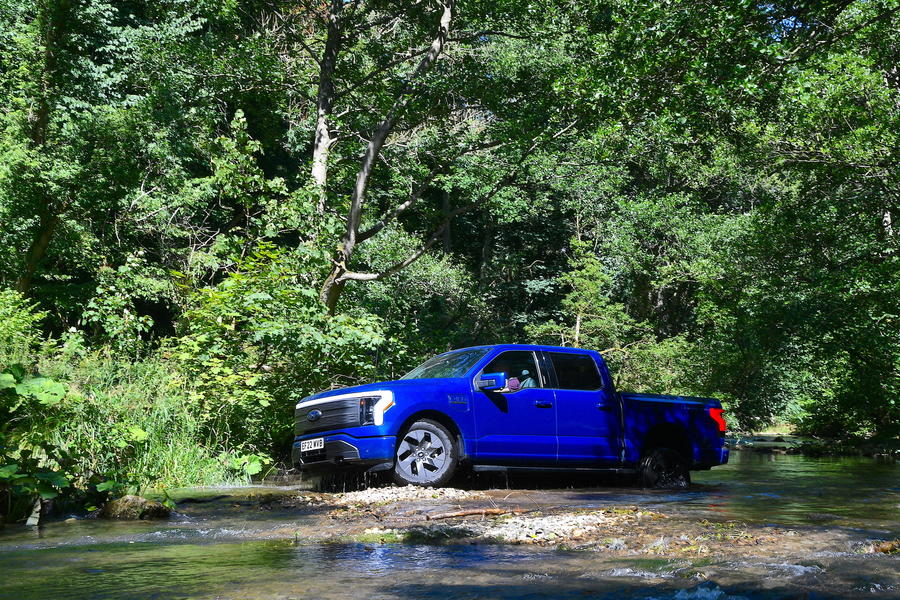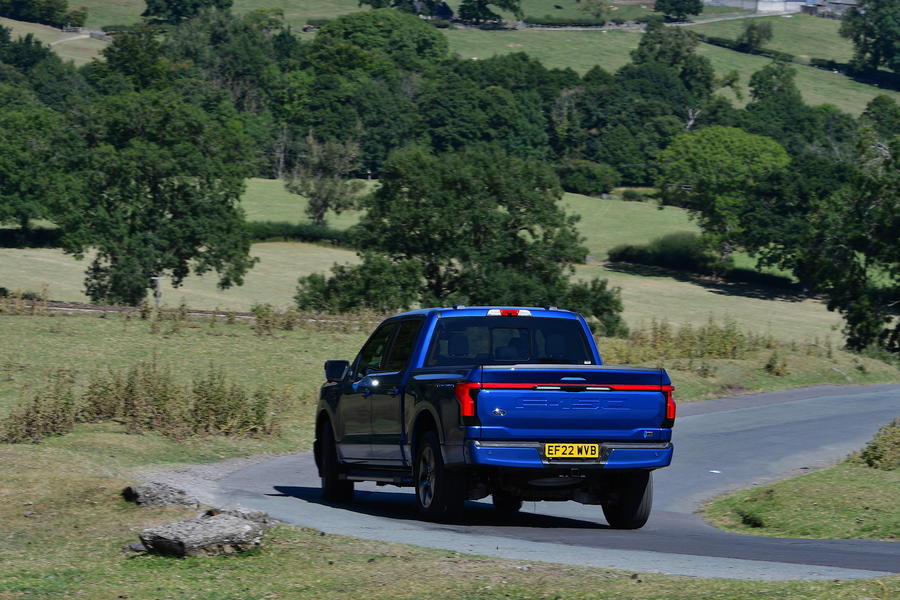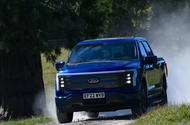Despite weighing nearly three tonnes, the F-150 Lightning hits 60mph in 4.3sec
Ford’s popular workhorse makes a huge statement in the electric truck game
Whichever number you pluck from the Ford F-150 Lightning’s spec sheet, you can guarantee it’ll be a whopper. Power, torque, weight, girth – they’re all much plumper than anything presented by cars we dare call ‘pick-ups’ over here in Europe. It’s the girth that proves most OTT on sinuous British roads, though. Taking up a whopping 2.4m with its elephant-ear mirrors folded out, this isn’t a car you’ll thread carefree down country lanes.
You’ll be feathering the throttle, too. There are currently two versions on sale in the F-150’s American homeland, both with a motor at each axle for four-wheel drive. The standard-range model peaks at 446bhp and 775lb ft, while the extended-range version boasts 572bhp but the same torque figure. I doubt you’ll mind too much, nor even notice. Despite weighing a sliver under three tonnes, it hits 60mph in 4.3sec. You know, like supercars used to…

However prodigious its power, though – all served up instantly, as is the electric way – this is an easy car to potter around in once you’ve got used to its size. The steering is quick by commercial vehicle standards, so even though it lacks any meaningful feel, the Lightning’s monstrous frame can be controlled with welcome ease. While independent rear suspension arrives as an F-150 first, there’s still a somewhat rudimentary feel to the chassis set-up, at least with a relatively empty bed. Nothing major, just the odd shudder over more sudden bumps and ruts that an SUV would comfortably iron out.
If that doesn’t seem like a fair comparison, then try sitting in a Lightning. With a huge portrait touchscreen transplanted from the Mustang Mach-E – alongside a swathe of luxurious trim and equipment on this Lariat spec – the vibe is closer to plush family transport than rough ’n’ ready workhorse. It’ll happily play the latter role, of course, and with a whole new trump card over the petrol-fuelled F-150s that have dominated US sales charts for decades.
The behemoth 131kWh battery doesn’t just turn a 2989kg block into an unfeasibly quick projectile but it can also power a dozen tools while out on the job. There are plug sockets everywhere, with a handful in the huge 400-litre frunk (which also has a drainage hole at the bottom), more in the vast five-seat cabin, and another bank just the other side of the electrically whirring tailgate. If a storm knocks the power off at home, the Lightning can tag itself in as a generator.

So while it can’t help but feel overendowed on British roads, that also makes it overqualified for just about any job you’ll throw at it. Quite how its range figure will be affected by proper utility it’s hard to say. Ford quotes up to 320 miles when you’re not hauling around a trailer or powering a chainsaw all day. Incidentally, towing capacity is 4.5 tonnes, giving some vague pragmatism to the gigantic torque figure, and there’s a complex trailer assist function built into a huge suite of driver assists.
Over here, it’s a fun irrelevance. Official imports look unlikely. But in its homeland, the Lightning appears an almighty line in the sand with the Tesla Cybertruck’s ETA edging up like a sat-nav’s in M25 gridlock. Ford wasn’t a pioneer with mainstream electric cars, but it has made a ginormous statement in the electric truck game. In more ways than one.
Stephen Dobie
Source: Autocar
